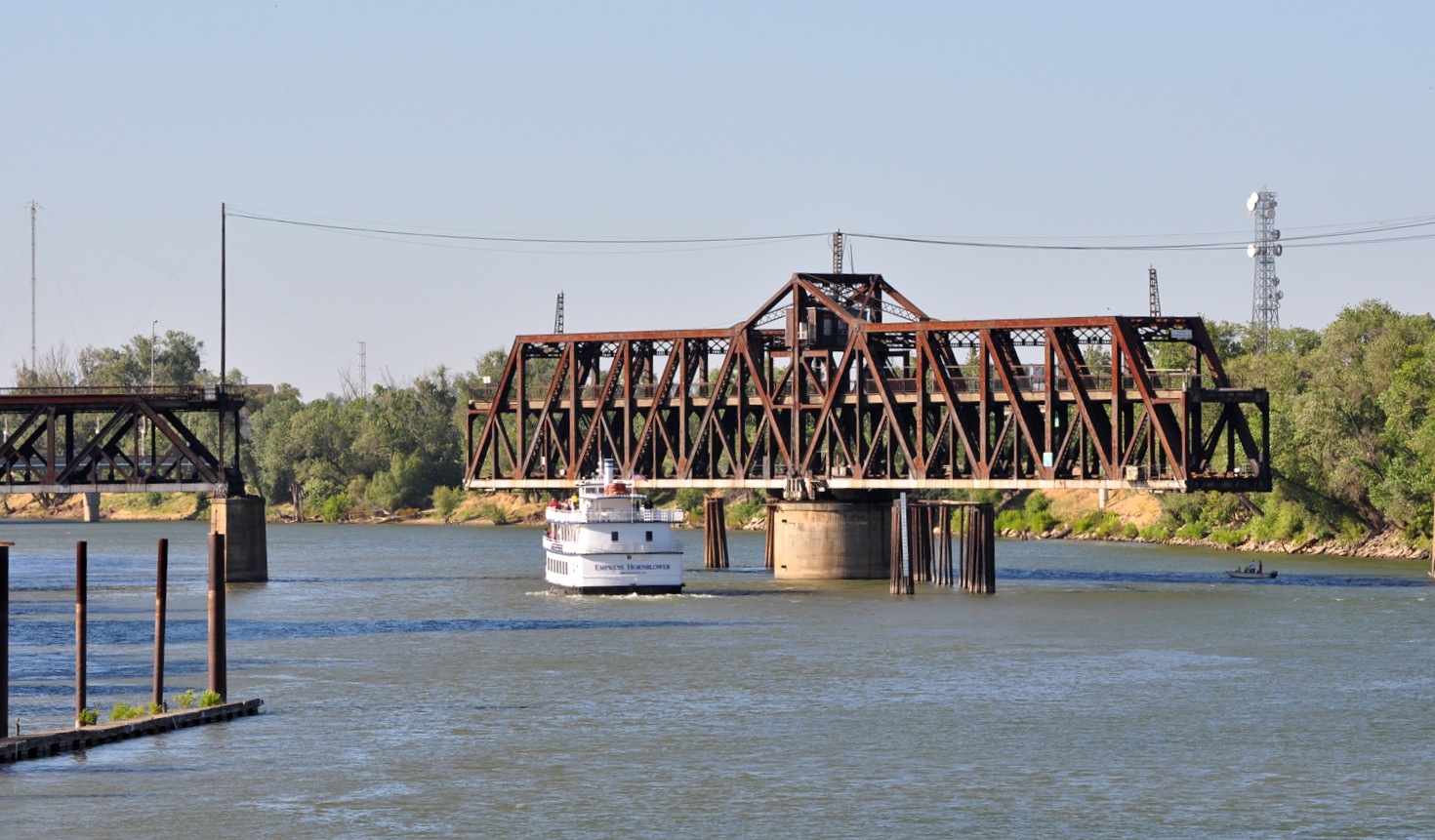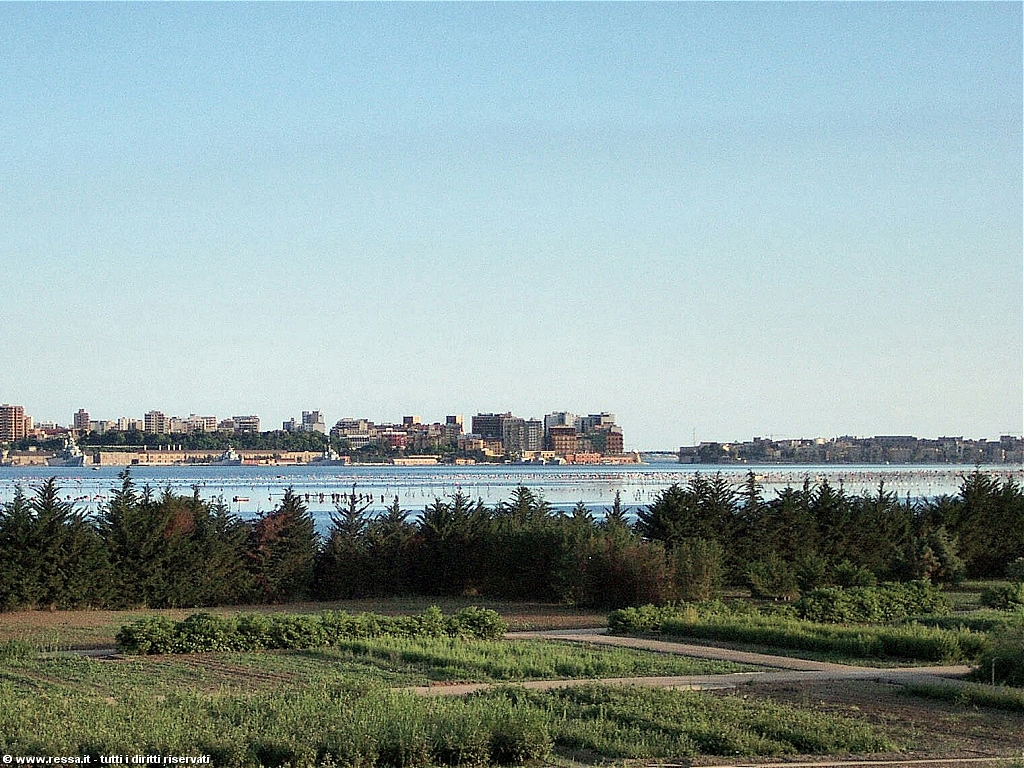|
Ponte Girevole
The Ponte Girevole is a swing bridge in Taranto, Italy, spanning the navigation canal between Taranto's Mar Grande and the Mar Piccolo. The bridge connects Borgo Antico (Old Town) island to the Borgo Nuovo (new Town) peninsula. The canal was excavated in 1481 as part of the defenses of Taranto. A steel and wood bridge was first built across the canal in 1886. The present steel bridge was built in 1958. Officially titled the Ponte di San Francesco di Paola, the bridge has two swing spans that pivot near the banks of the canal to meet in the middle of the canal. When open, the halves are parallel to the embankment, leaving the width of the canal clear for passage. The bridge is a Taranto landmark. The canal is long and wide. The first bridge was hydraulically operated using water stored in the Castello Aragonese. The 1958 replacement was designed by the National Society of Savigliano and built in the former Tosi shipyard in Taranto. It was inaugurated on 10 March 1958 by Italian p ... [...More Info...] [...Related Items...] OR: [Wikipedia] [Google] [Baidu] |
Taranto
Taranto (, also ; ; nap, label= Tarantino, Tarde; Latin: Tarentum; Old Italian: ''Tarento''; Ancient Greek: Τάρᾱς) is a coastal city in Apulia, Southern Italy. It is the capital of the Province of Taranto, serving as an important commercial port as well as the main Italian naval base. Founded by Spartans in the 8th century BC during the period of Greek colonisation, Taranto was among the most important in Magna Graecia, becoming a cultural, economic and military power that gave birth to philosophers, strategists, writers and athletes such as Archytas, Aristoxenus, Livius Andronicus, Heracleides, Iccus, Cleinias, Leonidas, Lysis and Sosibius. By 500 BC, the city was among the largest in the world, with a population estimated up to 300,000 people. The seven-year rule of Archytas marked the apex of its development and recognition of its hegemony over other Greek colonies of southern Italy. During the Norman period, it became the capital of the Principality of ... [...More Info...] [...Related Items...] OR: [Wikipedia] [Google] [Baidu] |
Italy
Italy ( it, Italia ), officially the Italian Republic, ) or the Republic of Italy, is a country in Southern Europe. It is located in the middle of the Mediterranean Sea, and its territory largely coincides with the homonymous geographical region. Italy is also considered part of Western Europe, and shares land borders with France, Switzerland, Austria, Slovenia and the enclaved microstates of Vatican City and San Marino. It has a territorial exclave in Switzerland, Campione. Italy covers an area of , with a population of over 60 million. It is the third-most populous member state of the European Union, the sixth-most populous country in Europe, and the tenth-largest country in the continent by land area. Italy's capital and largest city is Rome. Italy was the native place of many civilizations such as the Italic peoples and the Etruscans, while due to its central geographic location in Southern Europe and the Mediterranean, the country has also historically been home ... [...More Info...] [...Related Items...] OR: [Wikipedia] [Google] [Baidu] |
Swing Bridge
A swing bridge (or swing span bridge) is a movable bridge that has as its primary structural support a vertical locating pin and support ring, usually at or near to its center of gravity, about which the swing span (turning span) can then pivot horizontally as shown in the animated illustration to the right. Small swing bridges as found over canals may be pivoted only at one end, opening as would a gate, but require substantial underground structure to support the pivot. In its closed position, a swing bridge carrying a road or railway over a river or canal, for example, allows traffic to cross. When a water vessel needs to pass the bridge, road traffic is stopped (usually by traffic signals and barriers), and then motors rotate the bridge horizontally about its pivot point. The typical swing bridge will rotate approximately 90 degrees, or one-quarter turn; however, a bridge which intersects the navigation channel at an oblique angle may be built to rotate only 45 degrees, or ... [...More Info...] [...Related Items...] OR: [Wikipedia] [Google] [Baidu] |
Swing Bridge
A swing bridge (or swing span bridge) is a movable bridge that has as its primary structural support a vertical locating pin and support ring, usually at or near to its center of gravity, about which the swing span (turning span) can then pivot horizontally as shown in the animated illustration to the right. Small swing bridges as found over canals may be pivoted only at one end, opening as would a gate, but require substantial underground structure to support the pivot. In its closed position, a swing bridge carrying a road or railway over a river or canal, for example, allows traffic to cross. When a water vessel needs to pass the bridge, road traffic is stopped (usually by traffic signals and barriers), and then motors rotate the bridge horizontally about its pivot point. The typical swing bridge will rotate approximately 90 degrees, or one-quarter turn; however, a bridge which intersects the navigation channel at an oblique angle may be built to rotate only 45 degrees, or ... [...More Info...] [...Related Items...] OR: [Wikipedia] [Google] [Baidu] |
Castello Aragonese (Taranto)
The Castello Aragonese is a fortification in Taranto, Italy. Officially called the Castel San Angelo, it was built on the site of older fortifications dating to Greek occupation in the third and fourth centuries BC. In 1481 the low ground in front of the fortification site was excavated to allow the passage of boats, and to create a moated defensive position. The present fortress was built for the then-king of Naples, Ferdinand II of Aragon in 1496 to reinforce the naturally low-lying link between the old town of Taranto on a peninsula, and the mainland. The seven-towered design is attributed to Francesco di Giorgio Martini of Siena. The fortress repelled an Ottoman attack in 1594, but it quickly lost its military significance with the advent of artillery. It was converted to an artillery platform and many interior spaces were filled in to provide a stable base for the guns. In 1707 under the Habsburgs it was converted to a prison however during the Napoleonic period it reverted to ... [...More Info...] [...Related Items...] OR: [Wikipedia] [Google] [Baidu] |
Giovanni Gronchi
Giovanni Gronchi, (; 10 September 1887 – 17 October 1978) was an Italian politician from Christian Democracy who served as the president of Italy from 1955 to 1962 and was marked by a controversial and failed attempt to bring about an "opening to the left" in Italian politics. He was reputed the real holder of the executive power in Italy from 1955 to 1962, behind the various Prime Ministers of this time. Biography Early life and political career He was born at Pontedera, Tuscany, and was an early member of the Christian Movement founded by the Catholic priest don Romolo Murri in 1902. He obtained his first degree in literature and philosophy at the ''Scuola Normale Superiore di Pisa''. Between 1911 and 1915 he then worked as a high-school teacher of classics in several Italian towns (Parma, Massa di Carrara, Bergamo and Monza). He volunteered for military service in the First World War and when it was over he became in 1919 one of the founding members of the Catholic It ... [...More Info...] [...Related Items...] OR: [Wikipedia] [Google] [Baidu] |
Ponte Girevole (Taranto) Opening 1
The Ponte Girevole is a swing bridge in Taranto, Italy, spanning the navigation canal between Taranto's Mar Grande and the Mar Piccolo. The bridge connects Borgo Antico (Old Town) island to the Borgo Nuovo (new Town) peninsula. The canal was excavated in 1481 as part of the defenses of Taranto. A steel and wood bridge was first built across the canal in 1886. The present steel bridge was built in 1958. Officially titled the Ponte di San Francesco di Paola, the bridge has two swing spans that pivot near the banks of the canal to meet in the middle of the canal. When open, the halves are parallel to the embankment, leaving the width of the canal clear for passage. The bridge is a Taranto landmark. The canal is long and wide. The first bridge was hydraulically operated using water stored in the Castello Aragonese. The 1958 replacement was designed by the National Society of Savigliano and built in the former Tosi shipyard in Taranto. It was inaugurated on 10 March 1958 by Italian p ... [...More Info...] [...Related Items...] OR: [Wikipedia] [Google] [Baidu] |
Taranto Ponte Chiuso
Taranto (, also ; ; nap, label= Tarantino, Tarde; Latin: Tarentum; Old Italian: ''Tarento''; Ancient Greek: Τάρᾱς) is a coastal city in Apulia, Southern Italy. It is the capital of the Province of Taranto, serving as an important commercial port as well as the main Italian naval base. Founded by Spartans in the 8th century BC during the period of Greek colonisation, Taranto was among the most important in Magna Graecia, becoming a cultural, economic and military power that gave birth to philosophers, strategists, writers and athletes such as Archytas, Aristoxenus, Livius Andronicus, Heracleides, Iccus, Cleinias, Leonidas, Lysis and Sosibius. By 500 BC, the city was among the largest in the world, with a population estimated up to 300,000 people. The seven-year rule of Archytas marked the apex of its development and recognition of its hegemony over other Greek colonies of southern Italy. During the Norman period, it became the capital of the Principality of Tar ... [...More Info...] [...Related Items...] OR: [Wikipedia] [Google] [Baidu] |
Swing Bridges
A swing bridge (or swing span bridge) is a movable bridge that has as its primary structural support a vertical locating pin and support ring, usually at or near to its center of gravity, about which the swing span (turning span) can then pivot horizontally as shown in the animated illustration to the right. Small swing bridges as found over canals may be pivoted only at one end, opening as would a gate, but require substantial underground structure to support the pivot. In its closed position, a swing bridge carrying a road or railway over a river or canal, for example, allows traffic to cross. When a water vessel needs to pass the bridge, road traffic is stopped (usually by traffic signals and barriers), and then motors rotate the bridge horizontally about its pivot point. The typical swing bridge will rotate approximately 90 degrees, or one-quarter turn; however, a bridge which intersects the navigation channel at an oblique angle may be built to rotate only 45 degrees, or ... [...More Info...] [...Related Items...] OR: [Wikipedia] [Google] [Baidu] |
Bridges In Italy
A bridge is a structure built to span a physical obstacle (such as a body of water, valley, road, or rail) without blocking the way underneath. It is constructed for the purpose of providing passage over the obstacle, which is usually something that is otherwise difficult or impossible to cross. There are many different designs of bridges, each serving a particular purpose and applicable to different situations. Designs of bridges vary depending on factors such as the function of the bridge, the nature of the terrain where the bridge is constructed and anchored, and the material used to make it, and the funds available to build it. The earliest bridges were likely made with fallen trees and stepping stones. The Neolithic people built boardwalk bridges across marshland. The Arkadiko Bridge (dating from the 13th century BC, in the Peloponnese) is one of the oldest arch bridges still in existence and use. Etymology The ''Oxford English Dictionary'' traces the origin of the ... [...More Info...] [...Related Items...] OR: [Wikipedia] [Google] [Baidu] |
_opening_1.jpg)





